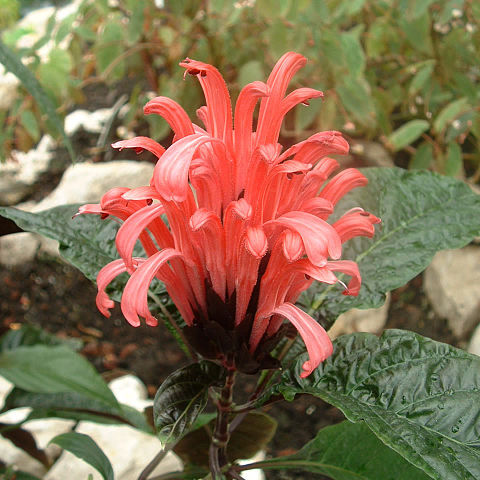Herbs, subshrubs, or shrubs, cystoliths present. Leaves sessile or petiolate; leaf blade margin usually entire but sometimes sinuate or slightly serrate. Inflorescences dichasia (sometimes reduced to a single flower) in leaf axils or axillary or terminal spikes, racemes, or thyrses, sometimes branched and becoming panicles; bracts variable in shape, sometimes prominent and/or brightly colored; bracteoles 2, similar to or smaller than bracts. Calyx deeply 4-or 5-lobed; lobes equal or subequal. Corolla tubular or funnel-shaped; limb strongly 2-lipped; lower lip 3-lobed; upper lip entire to 2-lobed, internally rugulate (i.e., with a stylar furrow); lobes ascending cochlear in bud. Stamens 2; anthers 2-thecous; thecae equally or unequally inserted, parallel to perpendicular, one or both spurred at base or sometimes lacking basal appendages; staminodes absent. Ovary with 2 ovules per locule; stigma slightly 2-lobed. Capsule with a sterile basal stalk and a fertile head (i.e., ± clavate), 2-4-seeded; retinacula present. Seeds compressed [to spheric].
Herbs or shrubs. Leaves petiolate, usually ovate to elliptic and entire. Inflo-rescences usually of spikes or panicles, occasionally in cymes or solitary; bracts various, small and distant, linear or subulate to large, conspicuous and imbricate. Flowers with the calyx segments usually narrow and equal, some unequal, mostly 5(4)-merous; corollas bilabiate, the corollas usually white, pink or purple, the tube usually narrow, funnelform, the upper lip 2-lobed, the lower lip 3-lobed; stamens 2, usually slightly exserted but not exceeding the corolla lip, the anther cells 2, usually unequal, often superposed, with one or both cells apiculate or calcarate, the connective narrow to broad. Capsules clavate, 4-seeded. This genus may be recognized by its 2 slightly exserted stamens with anthers having 2 cells which are frequently unequal, superposed and apiculate or cal-carate basally. This plus the bilabiate, narrow-tubed corollas and the lack of staminodes are useful features.
Cal nearly regular, cleft to near the base into linear or lanceolate lobes; cor 2-lipped, the upper lip concave, entire or emarginate, the lower spreading or deflexed, 3-lobed; stamens 2; pollen-sacs separate, one terminal, transverse or oblique, the other lateral; fr clavate or cylindric, the fertile part elevated on a long stipe-like base; seeds normally 2 per locule, orbicular; ours perennial herbs with narrow, sessile or subsessile, entire lvs and long-peduncled axillary spikes, the fls small, white to violet, each subtended by 3 minute triangular bracts at the base of the cal. 300, warm regions.

